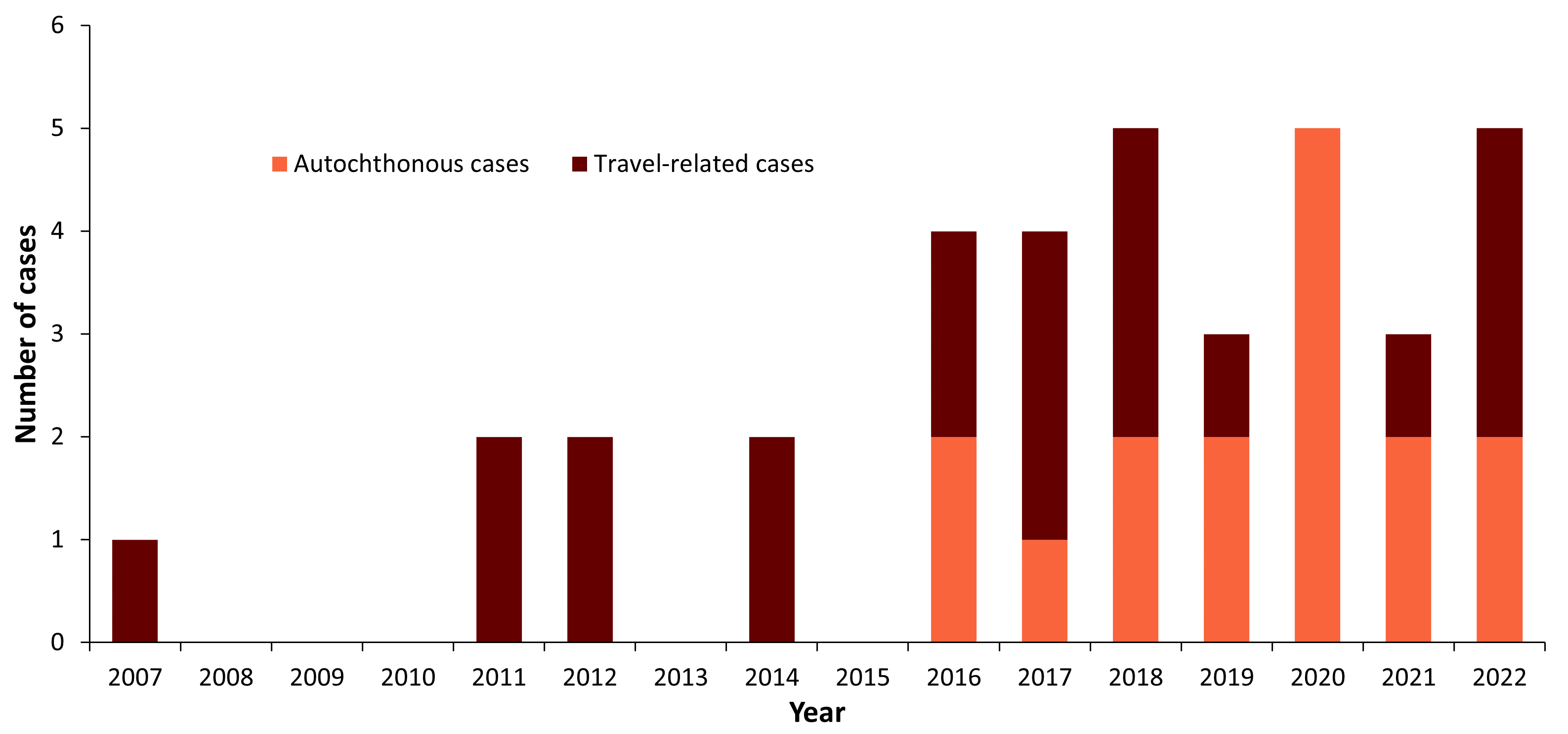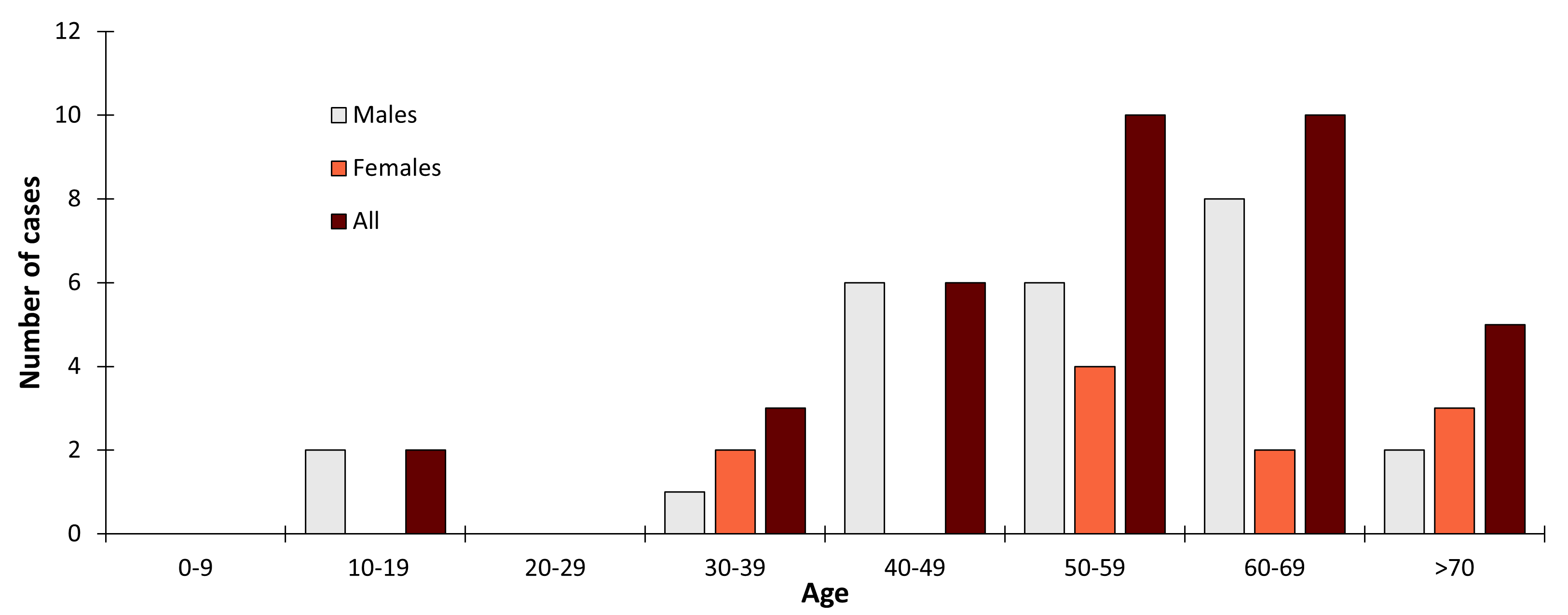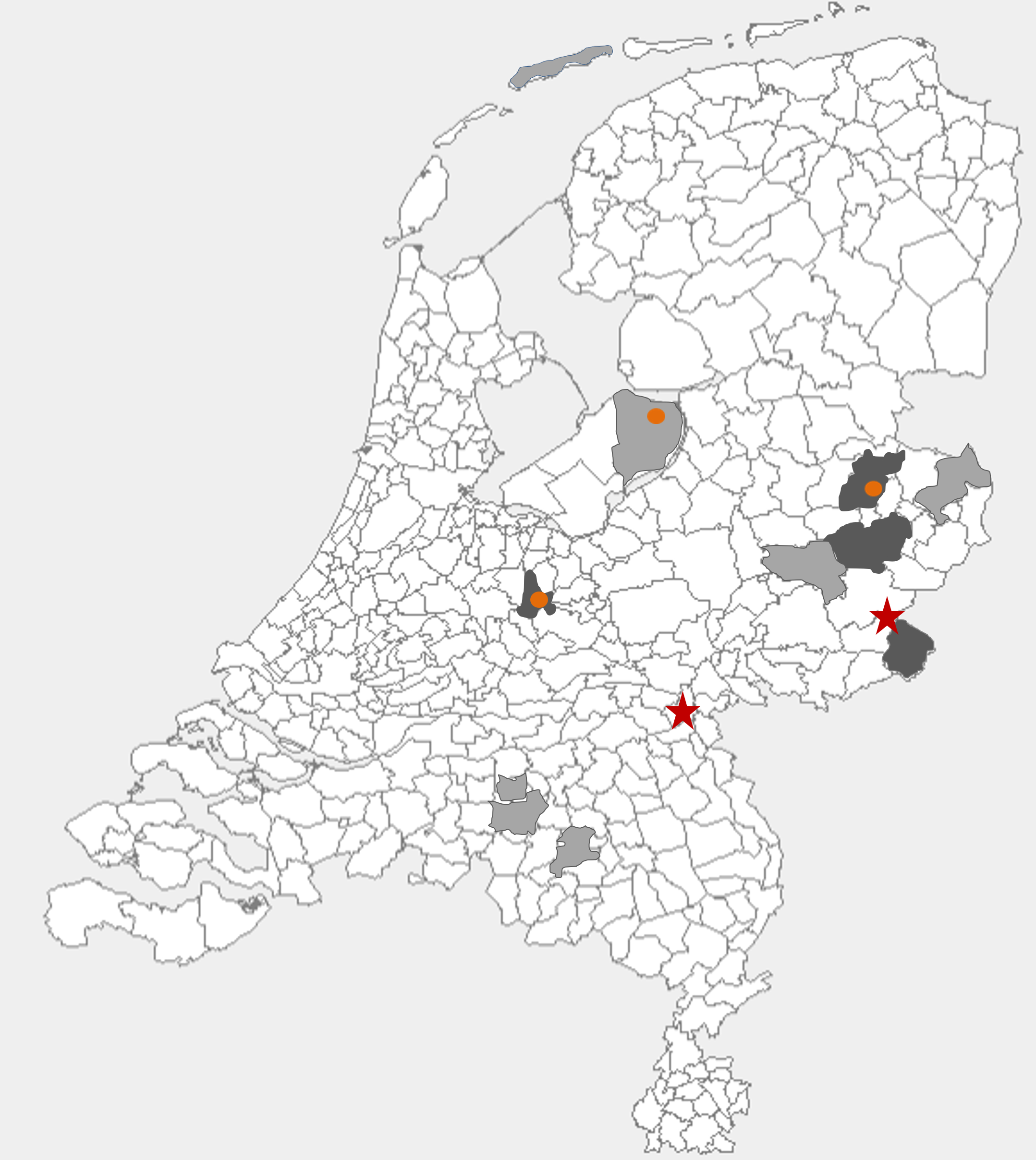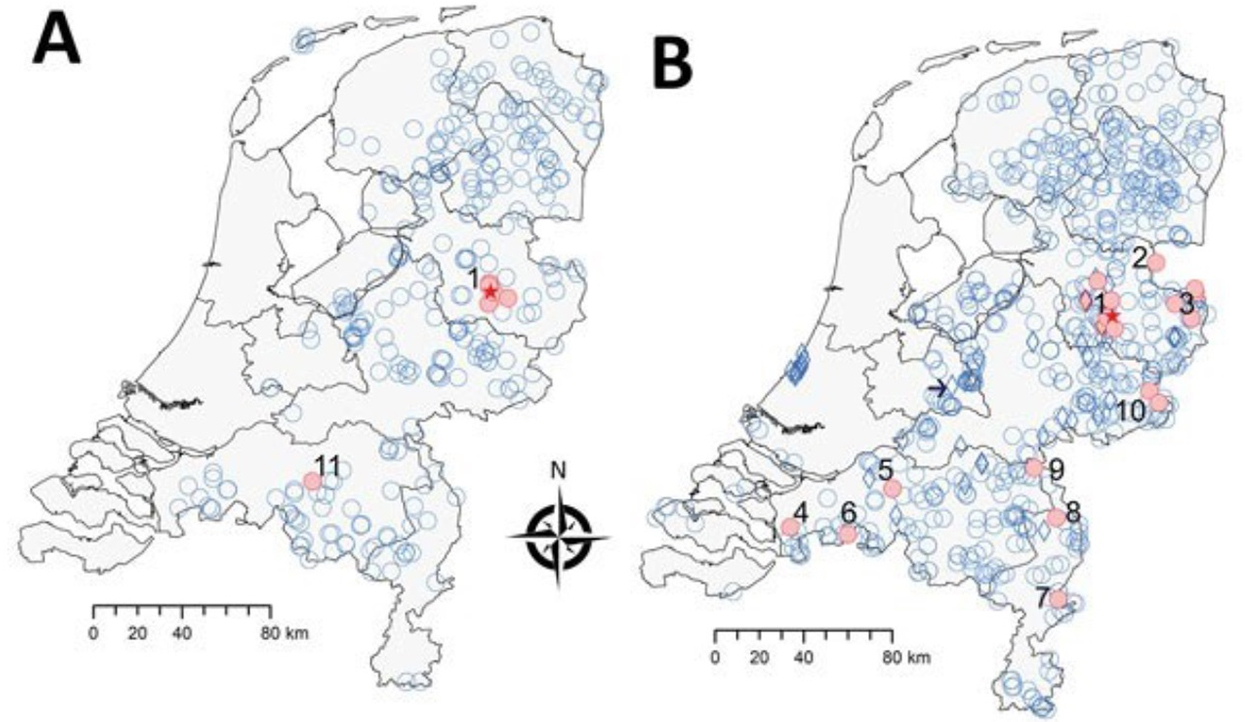Johannes Hermanus Jozef Reimerink, Hein Sprong, Margriet Harms and Chantal B.E.M Reusken
ECDC risk status: endemic
(data as of end 2022)
History and current situation
Until 2015, tick-borne encephalitis virus (TBEV) was presumed not to be endemic in the Netherlands.1,2 Consequently, the number of diagnostic requests for detection of tick-borne encephalitis (TBE) infection had been low. Between 2006 and 2015, the laboratory of the Netherlands Centre of Infectious Disease Control (Clb), 1 of the 2 laboratories that performed TBEV diagnostics in the Netherlands at the time, received an average of 20 (range 12–27) requests for TBE diagnostics per year. In the same period, TBE was diagnosed in 7 Dutch patients. All of these cases were considered to be travel-related. Indeed, 6 out of 7 patients reported that they had recently travelled to TBEV-endemic countries such as Austria (4), Germany (1), and Sweden (1).
In 2015, however, six out of 297 (2%) roe deer sera, collected in 2010, were found serologically positive for TBEV-infection.2,3 5 out of 6 sera centered at the national park “Sallandse heuvelrug” in the province of Overijssel, in the east of the Netherlands. The other TBEV-positive roe deer serum was collected in the south of the Netherlands, in the province of Noord-Brabant. Based on these findings, Ixodes ricinus ticks were collected at the “Sallandse heuvelrug” in 2015. From the approximately 1,460 ticks collected in 2015, one pool of nymphs (0.09%) and one pool of female adult ticks (0.33%) were PCR-positive for TBEV3,4. Sequencing of the viral genome revealed that the virus groups with the European (Western) subtype but is genetically distinct from all known Western European TBEV strains. Based on the near complete genome, the “Salland” strain diverges from currently known TBEV-Eu strains by 9% on nucleotides and 2% on amino acid levels, respectively.
In 2016, soon after the Clb raised national awareness about the presence of TBEV in the Netherlands, the first 2 autochthonous TBE cases were reported.5,6 Both patients were positive for TBEV by ELISA and virus neutralization test. The first patient most likely acquired TBEV when hiking at national park “Utrechtse Heuvelrug”,2,5 located in the center of the Netherlands (Fig. 3). A tick collected from this patient was RT-PCR-positive for TBEV. Interestingly, the virus strain from this tick was genetically similar to known Western European TBEV strains and differed considerably from the “Salland” strain (9% on nucleotide level, 2% on amino acid level). The second patient lived near national park “Sallandse heuvelrug” and frequently visited this park.2
Moreover, fourteen additional autochthonous human cases have been reported since. From the two autochthonous cases reported in 2022, one patient lived in a known endemic region in the east of the Netherlands, in the province of Gelderland and the other patient was reported outside the known TBEV loci on the island of Terschelling in the north of the country (Fig. 3). The reported case in Gelderland most likely acquired infection near his residence and the case in Terschelling lives in Leiden but contracted the infection during a holiday on the island. Additionally, three travel-associated TBEV infections were diagnosed in 2022 and most probably infected in Denmark, Sweden and Germany.
The number of laboratories implementing TBEV diagnostics stagnates at five with virus neutralization tests implemented at two. Despite the general availability of routine diagnostics in the Netherlands the number of diagnosed cases is still low. In 2017, a seroprevalence study conducted in roe deer identified additional potential TBEV foci, mainly located near the borders with Germany and Belgium (Fig. 4). In a study conducted in 2018 and 2019, ticks and/or rodents were sampled and tested for TBEV RNA on locations near to the places where seropositive roe deer were detected.11 TBEV RNA-positive ticks were found in the known foci as indicated in Figure 1 but additionally TBEV RNA-positive rodents were found outside the known foci (Fig. 1). Since 2020, cases were identified near newly identified potential TBEV foci and we hope that the awareness among clinicians for this recently emerged disease will grow outside the known endemic regions.
As it is not mandatory to report TBEV in the Netherlands,8 the exact number of requests for TBEV diagnostics and confirmed cases per year is currently not available.
In summary, in 2016, the first autochthonous TBE cases were reported in the Netherlands. Since then, 7 autochthonous cases have been recognized mainly in or close to the two known foci of presence. In 2020, we saw three TBE cases outside the known endemic regions which might be indicative for an expanding presence. However, TBEV was likely already present in these areas before 2020 according to the roe dear seroprevalence study in 2017. Awareness for TBEV is increasing in the Netherlands as reflected in the increasing number of labs that implemented diagnostics and the increase in requests for TBEV diagnostics at the CIb. Two different Western European TBEV strains have been detected in the Netherlands. Based on the fact that two autochthonous cases got infected near national park “Sallandse heuvelrug”, it is highly likely that the divergent “Salland” strain found in this area can cause disease in humans, but this remains to be confirmed.
Overview of TBE in the Netherlands
| Table 1: Virus, vector, transmission of TBE in Netherlands | |
|---|---|
| Viral subtypes, distribution | TBEV-EU (Utrechtse Heuvelrug)5,6
TBEV-EU “Salland” (Sallandse Heuvelrug)3 |
| Reservoir animals | Unknown(Roe deer were found to be sentinels and are likely dead-end hosts)3 |
| Infected tick species (%) | I. ricinus3-5 |
| Dairy product transmission | No information available |
| Table 2: TBE reporting and vaccine prevention in Netherlands | |
|---|---|
| Mandatory TBE reporting | It is not mandatory to report TBE in the Netherlands8 |
| Other TBE-surveillance | The five laboratories are requested to report seropositive samples |
| Special clinical features | No information available |
| Available vaccines | FSME-Immun® andFSME-Immun® Junior8 |
| Vaccination recommendations and reimbursement | Upon travel to TBEV-endemic areas vaccination can be considered8 |
| Vaccine uptake by age group/ risk group/ general population | No information available |
| Name, address/website of TBE National Reference Center | – |
Figure 1: Burden of TBE in the Netherlands over time

| Year | Number of cases |
|---|---|
| 2006 | 0 |
| 2007 | 1 (1 travel-related) |
| 2008 | 0 |
| 2009 | 0 |
| 2010 | 0 |
| 2011 | 2 (2 travel-related) |
| 2012 | 2 (2 travel-related) |
| 2013 | 0 |
| 2014 | 2 (2 travel-related) |
| 2015 | 0 |
| 2016 | 4 (2 travel-related) |
| 2017 | 4 (3 travel-related) |
| 2018 | 5 (3 travel-related) |
| 2019 | 3 (1 travel-related) |
| 2020 | 5 (0 travel-related) |
| 2021 | 3 (1 travel-related) |
| 2022 | 5 (3 travel-related) |
Figure 2: Age and gender distribution of TBE in the Netherlands

| Age group (years) | Males | Females | All |
|---|---|---|---|
| 0-9 | 0 | 0 | 0 |
| 10-19 | 2 | 0 | 2 |
| 20-29 | 0 | 0 | 0 |
| 30-39 | 1 | 2 | 3 |
| 40-49 | 6 | 0 | 6 |
| 50-59 | 6 | 4 | 10 |
| 60-69 | 8 | 2 | 10 |
| >70 | 2 | 3 | 5 |
Figure 3: TBEV-isolation and TBE cases in the Netherlands
Municipalities where the autochthonous TBEV cases likely acquired infection are depicted in grey (light grey: 1 case; dark grey: 2 cases). Locations where TBEV RNA-positive ticks were caught are indicated by an orange dot. Locations of TBEV RNA-positive rodent samples are indicated by a red star.11

Figure 4: Geographic distribution of tick-borne encephalitis virus (TBEV) based on serosurveillance of roe deer during A) 2010 and B) 2017
Red indicates roe deer serum samples that showed positive results in the TBEV neutralization test, and blue indicates roe deer serum samples that showed negative results in this test or an ELISA. Numbers indicate confirmed or potential foci, and red stars indicate location of 2016 TBEV-RNA positive ticks in Sallandse Heuvelrug National Park. (Figure and accompanying legend are reprinted from reference7).

Contact:
johan.reimerink@rivm.nl
Citation:
Reimerink JHJ, Sprong H, Harms M, Reusken CBEM. TBE in the Netherlands. Chapter 12b. In: Dobler G, Erber W, Bröker M, Schmitt, HJ, eds. The TBE Book. 6th ed. Singapore: Global Health Press; 2023. doi:10.33442/26613980_12b23-6
References
- Reusken C, Reimerink J, Verduin C, Sabbe L, Cleton N, Koopmans M. Case report: tick-borne encephalitis in two Dutch travellers returning from Austria, Netherlands, July and August 2011. Euro Surveill. 2011;16(44):20003.
- Schimmer B, Reimerink JH, Hira V, et al. First autochthonous cases of tick-borne encephalitis detected in the Netherlands, July 2016. 2016.
- Jahfari S, de Vries A, Rijks JM, et al. Tick-borne Encephalitis Virus in Ticks and Roe Deer, the Netherlands. Emerg Infect Dis. 2017;23(6):1028–30.
- Tekenencefalitisvirus aangetroffen in Nederlandse teken. [Tick-borne encephalitis virus found in Dutch ticks]. Signaleringsoverleg 26/2016. Bilthoven: Rijksinstituut voor volksgezondheid en milieu; 2016.
- de Graaf JA, Reimerink JH, Voorn GP, et al. First human case of tick-borne encephalitis virus infection acquired in the Netherlands, July 2016. Euro Surveill. 2016;21(33):30318.
- Hira V, de Graaf JA, Rockx B, authors of the original a. Author’s reply: The first tick-borne encephalitis case in the Netherlands: reflections and a note of caution. Euro Surveill. 2016;21(39):30356.
- Rijks JM, Montizaan MGE, Bakker N, et al. Tick-borne Encephalitis Virus Antibodies in Roe Deer, the Netherlands. Emerg Infect Dis. 2019;25(2):342-345.
- Dekker M, Laverman GD, de Vries A, Reimerink J, Geeraedts F. Emergence of tick-borne encephalitis (TBE) in the Netherlands. Ticks Tick Borne Dis. 2019;10(1):176-9.
- Geeraedts F, van der Kroft E, Reimerink J. First paediatric case of autochthonous tick-borne encephalitis in the Netherlands, 2018. New Microbes New Infect. 2019;32:100603.
- LCI-richtlijn Tekenencephalitis: RIVM; 2016. Available at: http://www.rivm.nl/Documenten_en_publicaties/Professioneel_Praktisch/Richtlijnen/Infectieziekten/LCI_richtlijnen/LCI_richtlijn_Tekenencefalitis.
- Esser HJ, Lim SM, de Vries A, et al. Continued Circulation of Tick-Borne Encephalitis Virus Variants and Detection of Novel Transmission Foci, the Netherlands. Emerg Infect Dis. 2022;28(12):2416-2424.